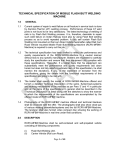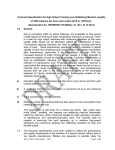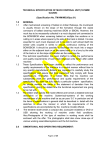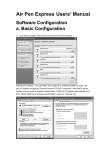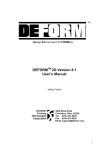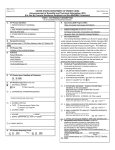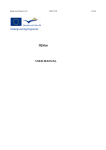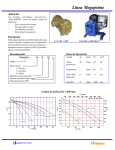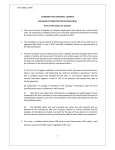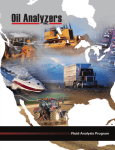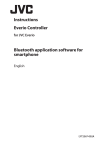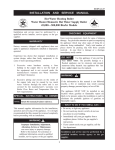Download technical specification of mobile flash butt welding machine
Transcript
TECHNICAL SPECIFICATION OF MOBILE FLASH BUTT WELDING MACHINE 1.0 GENERAL 1.1 Current system of repair to weld failure or rail fracture in service track is done by Alumino-Thermic (AT) welding process. Performance of these AT weld joints is not found to be very satisfactory. The latest technology of welding of rails is by Flash Butt Welding process. It is, therefore, desirable to repair such weld failure on Indian Railway track also by using Flash Butt welding process so as to avoid repeated problem. A fully self contain Flash Butt Welding Unit mounted on Rail cum Road Vehicle hereinafter called Rail Cum Road Vehicle mounted Mobile Flash Butt Welding Machine (RCRV-MFBWMachine) is required to carry out this job. 1.2 The technical specification has been drafted to reflect the performance and quality requirements of the RCRV-MFBW-Machine in a neutral manner without bias to any specific manufacturer. Bidders are requested to carefully study the specification and ensure that their equipment fully complies with these specifications. Thereafter, if a bidder feels that his equipment can substantially meet the performance and quality requirements laid down herein but does not fully satisfy a particular item of this specification, he shall mention the deviations, if any, in the statement of deviation from the specifications, giving the details how the functional requirements of this specification are going to be met with. 1.3 The bidder shall specify the model of RCRV-MFBW-Machine offered and furnish a detailed Technical Description of the same. System/sub-systems and working mechanisms of the machine as per Para ‘3’ and ‘4’ in particular and all the items of the specifications in general shall be described in the “Technical Description” in detail along with the sketches to show the manner in which the requirements of the specifications are accomplished by the offered model of RCRV-MFBW machine. 1.4 The tenderer shall furnish video compact disc showing the working of RCRVMFBW-Machine in real time under field conditions. Photographs of the RCRV-MFBW machine offered and technical literature shall also be enclosed with the offer. The photographs shall also show close-ups of various working assemblies/systems and the full RCRV-MFBW-Machine. 2.0 DESCRIPTION 2.1 RCRV-MFBW-Machine shall be self-contained and self-propelled vehicle consisting of following components: (i) Flash Butt Welding Unit. (ii) Carrier Vehicle (Rail cum Road). Page 1 of 43 2.2 Carrier vehicle shall be made by converting Standard Road Vehicle of adequate capacity into Rail Cum Road Vehicle. However Rail vehicle, duly converted into Rail Cum Road Vehicle will also be accepted subject to clearance of such vehicle from road authority of India for plying on Indian roads up to Major District Road (MDR) standard. Clearance certificate in this regard shall be submitted with the tender document. 2.3 Flash Butt Welding Unit mounted on such carrier vehicle shall be with all necessary requisites/attachments/manipulator etc. for carrying out all operations related to welding of rail joints as per Indian Railway’s Manual for Flash Butt Welding of Rails (Revised January 2012) with up to date Addendum and Corrigendum slips (hereinafter called Flash Butt Welding Manual). 3.0 DIMENSIONAL AND OPERATING REQUIREMENTS 3.1 The self driven diesel-powered RCRV-MFBW-Machine shall be heavy duty, robust, reliable and suitable for working and travelling on the Indian Railways Broad Gauge Track (1676 mm gauge). Quality assurance during manufacturing of the RCRV-MFBW-Machine shall be according to ISO-9001. The RCRV-MFBW-Machine shall be suitable for working on straight, transition and curved track (up to 10°) on Indian Railways. 3.2 The profile of the RCRV-MFBW-Machine longitudinally and in cross section during transfer as self-propelled vehicle on Railway track shall be within the Indian Railways Schedule of Dimensions –1676mm gauge (BG), Revised, 2004 with latest corrigendum and up to date correction slips. The maximum moving dimensions are shown in Annexure I. The tenderer shall provide sketches of the RCRV-MFBW-Machine, both in plan and elevation and shall give calculations for moving dimensions on 10° curve to show the extent of lateral shift at the ends, centre and any other relevant cross section to prove that the RCRV-MFBW-Machine does not cause any infringement while moving on a 10° curve at any cross-section. Where an infringement to Indian Railways Standard BG schedule of Dimensions (metric)-2004 is considered necessary by the manufacturer as intrinsic to the design of the machine for meeting the work performance requirements laid down in this specification while meeting the safety and operational requirements of IR, the same shall be done with the prior approval of the Purchaser and decision of the Purchaser in permitting any such infringement shall be final and binding on the manufacturer. Tenderers may note that acceptance of any such deviation during consideration of preliminary design details in the offer is only in principle acceptance and the final decision will be taken by the Purchaser at the stage of consideration of machine design for issuing speed certificate. In the past IR have condoned certain infringements to such dimensions as Rigid wheel Base, Length of stocks, Distance apart of bogie centres and maximum height of floor above Rail level in certain track machines after due consideration of their design features vis-à-vis safety and operation requirements of IR. However, condonation of an infringement in another Page 2 of 43 track machine in the past does not by itself entitle the manufacturer to assume acceptance of the same in other track machines by IR. 3.3 Adequate clearance shall be allowed so that no component/part infringes the minimum vertical clearance of 102 mm from rail level while traveling on track. 3.4 The axle load and other dimensional requirement of RCRV-MFBW-Machine shall comply with Motor Vehicles Act-1988 and the Central Motor Vehicles Rule-1989 with latest amendments, if any, for plying on Indian roads. The maximum safe axle weight as per the latest rule is reproduced below for guidance: Axle Single axle (single wheel) fitted with 1 tyre Single axle fitted with 2 tyres. Single axle fitted with 4 tyres. Single axle fitted with 8 tyres. Tonnes 3.0 6.0 10.2 19.2 The Road vehicle used should be Rigid vehicles. 3.5 The RCRV-MFBW-Machine when moving on track should be able to operate on the axle counters and track circuits used on Indian Railways system and the diameter of the rail wheels shall not be less than 730 mm. The minimum worn out wheel diameter permitted is 710 mm. The worn out wheel diameter based on the criteria of rail wheel contact stresses for various maximum axle loads on IR rolling stock are as under: Maximum Axle load (tonne) 20.32 20.0 19.5 19.0 18.5 18.0 17.5 17.42 Minimum worn out wheel diameter (mm) 816 805 787 768 750 732 713 710 3.6 When travelling on track, it shall be capable of negotiating curves up to 10° curvature (176 m radius), super elevation up to 185 mm and gradients up to 3%.The supplier shall specify the minimum attainable speed under the above limiting conditions which in any case shall not be less than 20 kmph. 3.7 The Rail Wheel Profile shall be as per Indian Railways Standard Wheel Profile provided in Annexure-II. Page 3 of 43 3.8 The rail wheel axle load shall be lesser than 20.32 tonne with minimum axle spacing of 1.83 meter. Load per meter shall not exceed 7.67 tonne. Lower axle spacing may be permitted, provided the load combinations do not cause excessive stresses in the tracks & bridges of IR. Stresses in the tracks & bridges shall be calculated and submitted by the machine manufacturer (based on design data) for verification of IR/RDSO. 3.9 It shall be capable of continuous operation during the varying atmospheric and climatic conditions prevailing throughout the year in India. The range of climatic conditions is as follows: a. Ambient temperature : -100 to 600C b. Altitude: : Sea level to 1800 m above mean sea level c. Humidity: : 40% to 100% d. Rail temperature : (-) 10° C to (+) 75° C 3.10 During transfer from one station to another (self propelled travel mode on railway track), it shall be capable of traveling on its own speed at preferably 50kmph but in no case less than 30 kmph in both directions. During towing of the RCRV-MFBW-Machine by another locomotive or by attaching to another load, neutral position of gears should be sufficient and speed should not be less than 20 Kmph. No opening of cordon shaft etc. should be required for safe movement. 3.11 It shall be capable of working and moving on Railway track without requiring power block in electrified sections. On Indian Railways, 25 KVA current is used for traction through an overhead wire at 5.5 m above rail level. On bridges and tunnels, the height is restricted to 4.8 m. 3.12 While working and moving on multiple Railway line sections, it shall not infringe the adjoining track and it shall be possible to permit trains at full speed on that track. During on-tracking/off-tracking, there should be no infringement with the adjacent railway tracks at level crossing. Minimum spacing of track is 4.265 m. The RCRV-MFBW-Machine or its any part shall not infringe adjoining track as per Schedule of Dimensions of Indian Railways during traveling or its welding operation including opening and closing of the work. The tenderer shall submit the details of the off-tracking and on-tracking arrangement of the machine at level crossing duly showing the methodology of prevention of infringement to adjacent track. 4.0 WORKING MECHANISM & FUNCTIONAL REQUIREMENTS: A. RCRV-MFBW-MACHINE AS A WHOLE: 4.1 The machine shall consist of a Flash Butt Welding unit mounted and fixed on Rail Cum Road Vehicle capable of moving on road as well as on rail and performing Flash Butt Welding of rail joints both on track and on cess. In addition to the Pneumatic tyres of Road vehicle, the Rail wheels for movement on Railway track will be provided separately. Page 4 of 43 4.2 The RCRV-MFBW-Machine shall be self-propelled and capable of moving in both directions. 4.3 The welding unit of RCRV-MFBW-Machine shall be fixed on a manipulator which should be mounted on the rear end of the machine and should be secured to the vehicle frame. It should have sufficient out stretch for welding of rails on track and also it should be capable of rotating sufficiently in both directions so as to also weld the rails placed in cess at minimum 3 m away from centre of track. If required, support from hydraulically operated outriggers fixed on the machine may be provided for stability of the machine during welding on cess. These out-riggers should be operatable from the main control panel as well as from a remote/portable control panel wherever provided. 4.4 The RCRV-MFBW-Machine should be so designed that the welding head along with its rail clamping device, rail pulling device, rail aligning device, rail lifting device, weld trimming device and their manipulator with necessary control panels and other arrangements should be out stretchable from the container for welding work and can be retreated back into the container after completion of welding. The complete operation of out stretching, retreating and rotation of units should be hydraulically controlled. 4.5 The welding operation should be such that there is no infringement to over head electric equipment during welding head maneuvering/extension/ shortening and there is no infringement to the Indian Railways Schedule of Dimensions – 1676mm gauge (BG), Revised, 2004 with up to date Addendum and Corrigendum slips. 4.6 It should be possible to start welding by the RCRV-MFBW-Machine at site within five minutes of its arrival including fixing of out-riggers etc. wherever required. The time required in complete welding operation from start to finish for one rail joint (excluding the time taken for post weld heat treatment wherever required and all rail/track related preparatory works) should not be more than 5 minutes. 4.7 The system should be fitted with an emergency backup arrangement to windup the welding unit and retract the unit and its manipulators into the container in all respect for cancellation of traffic block in the shortest possible time say 10 minutes. 4.8 All hydraulic hoses should either be fire proof or contained in fire proof sleeves. B. FLASH BUTT WELDING UNIT: 4.9 All components of Flash Butt Welding units should be housed in a self contained enclosure, lined and insulated with fire retarding sound proof Page 5 of 43 material and automatic fire protection system in the engine compartment. It should be suitable to be used for depot welding, on-track welding (weld renewal/replacing fractures/cess welding), and cess welding at construction sites. 4.10 The RCRV-MFBW-Machine should be designed to weld rails of various sections and metallurgies specified in Indian Railway’s Standard Specification for Flat Bottom Rails(IRS-T-12-2009) with up to date Addendum and Corrigendum slips (hereinafter called Specification of Rails) viz. 60/52Kg of grades 880(C-Mn, Cu-Mo, Ni-Cr-Cu, Niobium, Vanadium) and 1080(HH, Cr), continuously to form LWR/CWR in-situ or on cess or long rail panels in depot. 4.11 The welding unit should have a trimming arrangement as an integral part of the unit so that it can trim the excess upset immediately after welding. The weld should be in compression during trimming and removal of excess upset. The trimmer should have the capability to trim excess hot upset metal all round the rail section in such a way that minimum grinding is required to achieve final finished profile at weld as prescribed in Flash Butt Welding Manual which is enclosed herewith as Annexure-III. The maximum thickness of trimmed surface shall be in accordance with provisions of item (v) of Part ‘A’ & ‘B’ of Annexure-III. 4.12 It should be dual purpose unit that can be locked to do normal welding and also should have the capability of getting auto extended & using an integral rail pulling arrangement to do long closure welding up to minimum 200 mm of traction & 150 Ton minimum traction force. 4.13 The Unit should be able to do on track welding to repair rail gap with/without use of a rail pulling arrangement as per site requirement. Rail pulling arrangement should be integral part of the welding unit and should not be provided separately. 4.14 Rail pulling arrangement should be capable of generating adequate pulling force for doing in-situ welding in existing LWR/CWR tracks at required temperature as per the provisions of ‘Manual of Instructions on Long Welded Rails-1996’ for Indian Railways with up to date Addendum and Corrigendum Slips. 4.15 The welding process must be capable of welding new/ released but serviceable rails of various sections and metallurgies given in Specification of Rails. Suitability of Rails for flash butt welding is enclosed herewith as Annexure IV. Total rail usage per weld should be within 50 mm. Visible heat affected zone shall be of a nominally symmetrical shape about weld line and fall within the width of 40mm maximum and 20mm minimum. The permissible deviation between the maximum and minimum dimension of visible affected zone on any weld shall not exceed 5 mm. This requirement shall apply equally to vertical axis cut through full rail depth and those taken from each rail foot. Page 6 of 43 4.16 Quality of weld produced by the RCRV-MFBW-Machine should meet the various test standards and geometrical tolerances specified in Flash Butt Welding Manual. Geometrical tolerances are attached as Annexure-III and test requirements are attached as Annexure-V. 4.17 Welding parameters will depend on section and metallurgy of rail to be welded. These are normally specified by the manufacturer of welding plants which shall be got approved from RDSO before adoption for production of regular welds. Common welding parameters are as below : a) b) c) d) e) f) g) h) i) Welding current (primary, amps) Primary voltage (volts) Clamping pressure Kg/cm 2 Butting pressure Kg/cm 2 No. of pre-heats Pre-heating time On……………..Off…… Burn off time (sec.) Flashing time (sec.) Upset length i.e. rail usage per weld (mm) The machine should have the arrangement for displaying all the welding parameters including alignment (preferably). These parameters should be automatically stored in the system in reproducible electronic and hard forms in a manner such that each welded joint has a unique identity. As welding of higher UTS and higher section rails on low butting load plants by increasing the number of pre-heats causes very pronounced heat affected zone and is detrimental to the service life of the joint, RCRV-MFBW-Machine should have adequate butting load capacity to avoid the same. The recommended butting pressure for different types of rails being used in Indian Railways is as under: - 72 UTS rails- 5 Kg/mm2 on cross sectional area of rail. 90 UTS & Head Hardened rails- 6 Kg/mm2 on cross sectional area of rail. 110 UTS rails- 7 Kg/mm2 on cross sectional area of rail. 4.18 The Flash Butt Welding Unit should be of reputed make with proven credential. 4.19 72 UTS and 90 UTS rails do not require any special post weld heat treatment. However, alloy steel rails of 110 UTS and head hardened rails need post weld heat treatment to ensure variation in hardness within acceptable limits in heat affected zone. Therefore, machine should have a computer controlled, temperature controlled cooling process (based upon measurement of actual temperature) with post weld heat treatment arrangements like quenching etc. for welding of 1080 HH and 1080 Cr alloy rails. Page 7 of 43 4.20 The welding head should be adequately designed so that it does not get heated up during continuous welding of minimum 50 joints. A proper system should be provided for cooling of welding head. 4.21 Engine of adequate capacity for meeting the Flash Butt Welding requirement should be separately provided for welding operation. High-speed diesel oil conforming to Indian Standard Specification shall be normally used. 4.22 Unit should be equipped with quick change electrode inserts for various rail sections mentioned in Specification of Rails. Unit should also be equipped with compressed air pistol to ensure that electrical contacts i.e. copper/melloroy electrodes in the welding machine are free from loose oxides and other foreign matters so that no arcing takes place at the contact points on the rail. The welding system should have self-diagnostic software to allow easy maintenance and repair. 4.23 Unit should be able to meet with the welding requirements under the atmospheric and climatic conditions mentioned in 3.9 above. 4.24 The machine should have the provision that parameter once fixed in machine by Railway/Authorized person cannot be modified by the operator. Welding parameters for different section & metallurgy of rails used in Indian Railways shall be given by OEM (Original Equipment Manufacturer) with machine catalogue. However, before executing actual welding work, welding parameters are to be fixed by RDSO as per provisions of Para 5.6 of Flash Butt Welding Manual, attached herewith as Annexure V. Once rails clamped and ready for welding, the operator should have nothing to do after weld cycle starts except wait for the weld to complete and the software should facilitate auto-incorporation of the date and timing of welding from computer memory and this data should be un-editable. 4.25 The unit should be able to align the running surfaces of two rails at interface avoiding any step defect as per the provisions of Flash Butt Welding Manual attached as Annexure-VI. C. CARRIER VEHICLE (RAIL CUM ROAD): 4.26 The Road/Rail vehicle which is to be converted as carrier vehicle should be of robust design with capacity and chassis of sufficient length & strength for carrying Flash Butt Unit. The firm should submit the sketch and technical detail of this carrier vehicle. The chassis should be strong enough to take reversal of stress likely to be generated when changing from rail vehicle mode to road vehicle mode and vice versa. Page 8 of 43 4.27 The road vehicle where being converted into carrier vehicle should be of reputed make with proven credential and should be Euro III Compliant. 4.28 Rail Vehicle where being converted to Rail Cum Road Vehicle (carrier vehicle) should be suitable to run on Indian Railways Network. 4.29 Carrier vehicle should be capable of moving on Road and Railway track when it will be said to be moving in Road Moving Mode and Rail Moving Mode respectively. 4.30 The Carrier vehicle for movement in Rail moving mode should have single axle in front for guiding and a bogie with two powered axle in rear for driving. The wheels should be solid with or without rim and no spokes/perforations are permissible. 4.31 For changing carrier vehicle from Road movement mode to Rail movement mode or vice-versa, hydraulic system should be provided for lowering and lifting of the front and rear Rail wheels and transferring vehicular load on these wheels. 4.32 When in Rail movement mode, the complete load should be on Rail wheels and Road vehicle with welding units and other accessories along with its pneumatic tyres should be completely lifted above track. Suspension lock should be provided for the suspended original Road Vehicle for securing the Road vehicle along with its unit. 4.33 In Road movement mode, the rail wheel should be lifted and should have minimum clearance permitted as per Road Vehicle Act to avoid any infringement. 4.34 Rail Traction wheels of the Carrier Vehicle should be provided with hydrostatic drive. 4.35 The Carrier Vehicle in Rail movement mode if provided with mechanical drive should have minimum three speed front gears and three speed back gears. 4.36 The Carrier Vehicle in Rail movement mode should be compatible with IR track circuiting & signaling installations. 4.37 Carrier Vehicle should have stabilizing arrangement to ensure higher stability while welding on track. 4.38 During welding, the rail being welded should be released of the vehicle load. Adequate capacity hydraulic jack/out-riggers should be provided separately for both left hand and right hand rail for this purpose. These jacks/out-riggers should be fixed on the body frame of the vehicle and should be operatable from suitable location without any infringement to Schedule of Dimensions. Page 9 of 43 4.39 Carrier Vehicle in Road movement mode should be provided with normal road braking system of the Road vehicle manufacturer. 4.40 The Carrier Vehicle of the RCRV-MFBW-Machine should have indigenous diesel engine (prime mover) with proven record of service in tropical countries. Robust construction and low maintenance cost are of paramount importance. There should be satisfactory service/repair support facilities available throughout India. 4.41 Prime mover of adequate capacity should be ensured, particularly if, the same prime mover of Carrier Vehicle is being used for traction on rail and road. The tenderer should submit the tractive effort verse speed characteristics and also give the tractive effort requirement calculations for various configuration to assess the prime mover adequacy. 4.42 High-speed diesel oil conforming to Indian Standard Specification shall be used. 4.43 A minimum fuel tank capacity sufficient for continuous operation for 8 hrs and minimum 100 joints will be desirable. 5.0 GUARANTEE CLAUSE: In addition to the special conditions of contract dealing with warranty, the following will apply. Should any design modification be made in any part of the equipment offered, the period of 24 months would commence from the date of the modified part is commissioned in service for the purpose of that part and those parts which may get damaged due to defects in the new replaced part, the cost of such modification should be borne by the supplier. 6.0 COOLING SYSTEM: 6.1 The cooling system shall be efficient and designed for maximum ambient temperature of 60°C. Supplier may note that the RCRV-MFBW-Machine shall be working under extreme dusty conditions and the cooling mechanism should be maintainable under these conditions for all prime movers. 6.2 Adequate heat transfer arrangement for the hydraulic system shall be designed and provided so that under extreme heat conditions as mentioned in 3.9 above, the temperature of system oil does not go beyond limit recommended by Oil Company. Page 10 of 43 7.0 BRAKES: 7.1 The RCRV-MFBW-Machine for working on Rail movement mode shall be equipped with pneumatically/hydraulically operated brake blocks active on all rail wheels with an additional fail safe brake application arrangement. In addition, the RCRV-MFBW-Machine shall be equipped with a mechanically/pneumatically/hydraulically operated parking brake system. 7.2 There should be provision of emergency brake application in the machine for working on Rail movement mode in addition to the normal braking system using the compressed air. The firm should submit design calculation for the braking effort and EBD at the maximum design speed of the machine on level track and at falling gradient of 1 in 33. The brake design details are to be submitted as per Annexure-VII. Emergency Braking Distance (EBD) on level track at maximum design speed shall not be more than 200 mtrs. On falling gradient of 1 in 33, it should not be more than 600 mtrs. 7.3 All braking systems shall be protected from ingress of water, grease, oil or other substances, which may have an adverse effect on their performance. 7.4 All brake lining shall be suitable for high ambient temperature of 55° C. The force required for operating the brake for rail wheel when moving on Rail movement mode shall not exceed 10 Kg at the handle while applying by hand and 15 Kgs. on the pedal, when applied by foot. 7.5 Air reservoir should be so designed as to meet the air reserve requirement for repeated braking under normal condition. 7.6 In Road movement mode, the braking power should be adequate for the load of the vehicle and satisfy the provisions in motor vehicle act. 8.0 HORN AND SAFETY SWITCHES: The RCRV-MFBW-Machine shall be provided with electric horns/hooters facing outwards at each end of the RCRV-MFBW-Machine at suitable locations to warn the workmen of any impending danger at the work spot or from oncoming train. These electric horns/hooters shall be operatable from the cabin and the back end of the machine. 9.0 HOOKS AND BUFFERS: The RCRV-MFBW-Machine shall be fitted with suitable arrangement like hooks etc. on both ends. A suitable transition coupler, sufficiently strong and of design compatible to attach existing couplings in locos/ rolling stock of IR to the arrangement in RCRV-MFBW-Machine be provided for towing of the RCRV-MFBW-Machine. Page 11 of 43 10.0 ELECTRIC EQUIPMENT AND LIGHTING: The electrical fittings/instruments including head lights to be provided on the Carrier Road Vehicle shall conform to relevant Motor Vehicle Rules. For Rail movement mode, additional twin beam headlight assembly to be provided conforming to RDSO Specification No. ELRS/SPEC./PR/0024 Revision-1 Sept.,2004 with the amendments ensuring a light intensity of 3.2 lux at ground level at track centre at a distance of 305 m away on a clear dark night at each end with two front and rear parking lights which can be switched to red or white according to the direction of the travel. Powerful swiveling floodlights shall also be provided to illuminate the working area sufficiently bright for efficient working on railway track during night. The amber color flasher lights at both ends shall be provided in the RCRVMFBW-Machine to give indication for the train arriving on other line when working on track about any impending danger. 11.0 CABIN: 11.1 All operations for travel shall be controlled from a spacious fully enclosed cabin with safety glass, permitting unobstructed view and movement in both directions in Rail movement mode. For additional visibility during movement in reverse direction, CCTV or any other suitable and adequate arrangement may be provided. The details of arrangement for visibility during reverse movement should be submitted with the offer. 11.2 In view of the high ambient temperature prevailing in India, special attention should be paid to free circulation of air and ventilation in the driver’s cabin. Cabin fans of adequate capacity shall be provided in the cabins. 11.3 Seating arrangement for 4 persons in addition to the driver shall be provided in the cabin. 11.4 Fire extinguisher (dry chemical type) shall be provided in the cabins. 11.5 The Machine shall be provided with adequate space for keeping the tools, equipments and spares required for on-site repair of the machine and other working requirements. 12.0 TOOLS AND INSTRUCTIONS MANUALS: 12.1 Each RCRV-MFBW-Machine shall be supplied with a complete kit of tools required by the operator in emergency and for normal working of the machine. The list of tools to be provided shall also include all tools necessary for maintenance and repair of the entire RCRV-MFBW-Machine including specialized equipment. All special tools shall be listed and catalogued illustrating the method of application. Page 12 of 43 12.2 Detailed operating, maintenance, service and major assembly/component overhauling manuals shall be specifically prepared in English language and four copies of these shall be supplied with each machine. 12.3 As a part of service manual, the manufacturer shall also supply circuit diagram of electrical, hydraulic, pneumatic and electronic circuits used on the machine. Troubleshooting diagram/table shall also be supplied. In additions, the manufacturer shall provide dimension drawings with material description of items like rubber seals, washers, springs, bushes, metallic pins etc. Performance specification/working parameters and standard part numbers with supplier name of items like hydraulic pumps-motors and such other bought out components/assemblies shall be furnished by the tenderer. This shall be in English language and four copies of these shall be supplied with each RCRV-MFBW-Machine. 12.4 While offering the RCRV-MFBW-Machine for first inspection, the supplier shall submit one copy of complete technical literature in English language including operation, service and field maintenance manuals/instructions, spare catalogue and complete electric/electrical, hydraulic and pneumatic circuit diagrams, troubleshooting charts, component drawings/description and other relevant technical details as reference documents for the inspecting officer. 12.5 The firm shall provide detail technical drawings and specifications of wheels and axles used in a machine. The above details shall be provided in four sets. 12.6 One additional set of all the manuals and diagrams/drawings should also be sent each to the Track and TMM Directorate of RDSO, Lucknow, Track Machine Directorate of Railway Board and Director /IRICEN, Pune along with supply of first machine of similar group. In case there is any subsequent amendment in any document based on field performance, the amendment/ amended documents should also be sent to above mentioned authorities. 13.0 SPARE PARTS: The tenderer should quote apart from main equipment –separately for the mandatory spare as well as the recommended spares for two years of operation along with description, part no., quantity, cost, whether imported or indigenous. The expected life of component shall be advised along with condemning limits. The suppliers shall be responsible for the subsequent availability of spare parts to ensure trouble free service for the entire life of the machine as a whole (15 years). 14.0 MAKER’S TEST CERTIFICATE: Copies of the Maker’s certificate of different units guaranteeing its performance and the maker’s certificate guaranteeing the performance of the Page 13 of 43 RCRV-MFBW-Machine as whole shall be supplied in duplicate along with the delivery of each RCRV-MFBW-Machine. 15.0 OPERATORS: The number of operators and allied staff for working of the RCRV-MFBWMachine under normal condition shall be indicated, specifying their duties and minimum qualifications. 16.0 INSPECTION OF THE MACHINE: 16.1 While inspecting the machine before dispatch from the supplier’s premises, the inspecting officer shall verify the conformity of the machine with respect to individual specification as above. The conformity/non- conformity with respect to each item shall be jointly recorded before issue of the Inspection certificate and approval for dispatch of the machine as per Annexure - VIII enclosed. 16.2 Following arrangements shall be made by the supplier/Manufacturer at the inspection premises for carrying out inspection of the machine by inspecting officials: Machine to be stabled on straight & level BG track. The length of the track should be at least 10 m more than buffer to buffer length of machine. In order to check Maximum Moving dimensions in cross section, a Sturdy frame of IR Max Moving Dimensions shall be provided by the manufacturer and passed over the machine holding it perpendicular to track, centre aligned with track centre. Adequate arrangements shall be made to the satisfaction of inspecting official. 16.3 The following documents shall be provided to the Inspecting Officer at least 4 weeks in advance of the date of inspection. i) One copy of complete technical literature mentioned in clause 12, in English language, including operation, service and field maintenance manuals/ instructions and complete electrical, hydraulic and pneumatic circuit diagrams, trouble shooting charts, component drawings/ description and other relevant technical details as a reference documents for the inspecting officer. ii) Cross section of the machine super imposed on IR maximum moving dimensions envelope shall be provided to Inspecting Officer in advance. iii) Clause by clause comments of the manufacturer on this specification to be sent to Inspecting Officer (IO) in advance for his review. Comments should state manufacturer’s conformity/ compliance of each of the requirement stated in each clause, elaborating wherever necessary the details/manner in which the requirement has been complied. The proforma for the clause-wise comments is given below: Page 14 of 43 Clause No. Clause Comments of Comments of Supplier/manufacturer Inspecting Officer iv) Manufacturer’s Internal Quality Inspection Report of the machine. v) Manufacturer’s quality certificate and/or test reports for bought out assemblies/sub-assemblies to be provided to IO, containing serial number wherever applicable. vi) Draft Inspection Report to be prepared by the manufacturer, containing all annexure mentioned at Para 16.4. vii) Details of arrangements made for checking Maximum Moving Dimensions for his approval. Supplier will incorporate amendments/further clarification in the above documents to the satisfaction of the Inspecting Officer keeping in view the Inspecting Officer’s comments, if any. 16.4 List of documents to be annexed in the draft Inspection Report should include: i. Maker’s Test Certificate. ii. Manufacturer’s Internal Quality Inspection Report. iii. Quality Certificates of Bought out assemblies/sub-assemblies. iv. Cross section of the machine super imposed on the IR MMD. v. Vogel’s diagram. vi. List of spare parts to be dispatched along with the machine. vii. List of tools to be dispatched along with the machine. viii. List of Manuals, Drawings, Spare Parts Catalogues, etc. to be dispatched along with the machine, duly indicating the number of sets of each. The above documents shall form part of final inspection report. 17.0 OPTIONAL EQUIPMENTS: The tenderer is expected to quote for optional equipment or features separately for each item giving the advantages and functions of such optional equipment. The tenderer shall also indicate whether such equipment is already in use on machines elsewhere indicating the user railway system. 18.0 SERVICE ENGINEERS AND OPERATIONAL BASE IN INDIA: 18.1 The supplier, after supply of machine shall establish a permanent operational base in India for providing necessary technical support in terms of the Page 15 of 43 maintenance and shall also provide assistance and logistics support concerning problem within and beyond the warranty period. 18.2 The contractor shall provide at his own expense the services of competent engineers during the warranty period for warranty related issues and for future product support. The service engineers shall be available for the commissioning of the RCRV-MFBW-Machine for regular service and for training of the operating, repairing and maintenance staff of the machine. RCRV-MFBW-Machine shall be inspected by OEM or his authorized representative at an interval of two years or execution of 20,000 joints whichever is earlier to conduct technical audit of its health. The engineers shall also advise the railways on appropriate maintenance, testing, operating, repair and staff training facilities that are necessary for the efficient performance of the RCRV-MFBW-Machine. 18.3 Trained Service Engineers should be available in India for ensuring quick repair in case of breakdown of the RCRV-MFBW-Machine. 18.4 During the warranty period of the machine, the supplier must ensure trouble free availability of the machine in good working condition for at least 90% of the time and accordingly they must ensure availability of spares and services of competent service engineers and prompt disposal of complaint of user railways. 19.0 ISSUE OF PROVISIONAL SPEED CERTIFICATE: 19.1 Whenever a new rolling stock is introduced in Indian Railways, a provisional speed certificate is issued by RDSO based on certain design parameters of the vehicle. The firm shall submit design data as per Annexure-IX. Final speed clearance of the vehicle is given after conducting detailed oscillation trial of the vehicle, which is a time taking process. Therefore, issue of provisional speed certificate for the vehicle becomes a necessity and based on the same, the approval of running of the vehicle on Indian Railway track is taken from commissioner of Railway Safety. For issue of provisional speed certificate, the following actions are required to be taken by the suppliers: a) Current suppliers, whose models are approved: The supplier shall give details of the model, year of introduction in Indian Railway, details of speed certificate issued etc. The supplier shall certify that no change has taken place in the model being offered with respect to design of under carriage i.e. suspension system/arrangement, wheel & axle assembly, bogie, braking arrangement, loading pattern of the vehicle etc. and the distribution of axle loads, lateral forces, un-sprung mass and braking force coming on rails is the same. If, there is any change in above respect, the action shall be taken as detailed in para (b) below: b) Current suppliers, whose models are new and not approved: As soon as the supplier completes the design of the machine as per Specifications, the technical details as per Annexure (X/A, X/B & XI) shall Page 16 of 43 be supplied for processing of provisional speed certificate for the machine so that it can be permitted to move on track. On case-to-case basis, more technical details (other than mentioned in Annexure X/A, X/B & XI) can also be asked for issue of provisional speed certificate for the machine. c) New suppliers, whose models are new: The technical details shall be supplied as detailed in para (b) above. 20.0 ACCEPTANCE TEST: Apart from verification of the various items of specification covered above, the following tests shall be carried out by the supplier in India in the presence of purchaser’s representative at the time of commissioning of the RCRVMFBW-Machine. (i) (ii) (iii) (iv) (v) (vi) Dimensional check of RCRV-MFBW- Machine loading gauge, i.e. maximum moving dimensions, clearances, length of machine, bogie distance etc in Road as well as Rail moving mode. Testing for negotiability on 1 in 8 ½ turnouts. Testing of out stretch and rotation of the manipulator as per requirement in the Para 4.3. Running test of RCRV-MFBW- Machine in Rail moving mode for satisfaction to provisions of clause 3.10. Test to be conducted as per the provisions contained in Annexure-XII. Running test of RCRV-MFBW- Machine in Road moving mode for minimum 40 kmph self propelled speed. Testing of Flash Butt Welding Unit. 25 test welds each in 60 Kg/90 UTS and 52 Kg/90 UTS rail sections will be made both in cess and in depot (Total 4X25=100). In addition, 10 test welds in 52 Kg/60 Kg 90 UTS rail section will be made in running track using pulling & traction facility of the machine. Welding parameters for acceptance test are to be decided by manufacturers/ suppliers of the machine. a) Not more than one test weld of each type i.e. 60 Kg/90 UTS, 52 Kg/90 UTS rail sections made in cess and in depot and 52 kg /60kg 90 UTS made in running track should fail in visual inspection, weld trimming and upset examination, step across the weld examination, dimensional check and ultrasonic testing as per the provisions of Flash Butt Welding Manual (Annexure V). In case the failure is more than above specified limit, one more set of equal no. of similar type of test welds which have failed, will be executed and tested for above mentioned parameters. None of the test welds should fail in the re-test conducted for above mentioned parameters or else the machine will be said to have failed to meet the specification and the machine will not be accepted. Page 17 of 43 b) If the test weld have passed the criteria mentioned in the Para (a) above, 04 test welds of each type i.e. 60 Kg/90 UTS, 52 Kg/90 UTS rail section made in cess and in depot and 02 test welds in 52 Kg/60 Kg 90 UTS made on running track shall be randomly selected for conducting hardness testing, transverse load testing, macro and micro examination as per the provisions of Flash Butt Welding Manual (Annexure V). None of these test welds should fail in the above tests. In case of any failure, another set of four similar type of test welds which have failed, shall be randomly selected from the above prepared welds and the test shall be repeated. None of the welds should fail in the re-test so conducted. In case of any failure, the machine will be said to have failed to meet the specification and the machine will not be accepted. c) At the time of preparing the test welds, 10 welds made in cess and 04 welds made on running track will be considered for measuring the output of the offered machine. Average time required in complete welding operation from start to finish including trimming for one rail joint prepared in all respect excluding post weld heat treatment wherever required and rail/track related preparatory works, should not be more than 5 minutes. d) At the time of preparation of test welds on running track, the traction and pulling capacity of the machine shall be verified and should meet the provision of Para 4.12 of this specification. The machine shall be commissioned after pre-commissioning test within 90 days of its arrival at the final consignee end. 21.0 Should any modification be found necessary as a result of the tests, these shall be carried out once by the supplier at his own expense after which the modified machine shall again be subjected to relevant tests mentioned in this specification for confirmation and acceptance of the machine, failing which the offered machine under consideration shall be rejected. 22.0 MARKING & COLOUR OF MACHINE: 22.1 The machine body shall be painted in golden yellow colour (Colour code to be ISC: 356) conforming to RDSO specification No M & C/PCN/109/88 (with latest amendment) to minimum DFT of 80 mm. 22.2 Following should be written on the machine at appropriate location: i) Indian Railways logo of height between 300 mm to 600 mm as suitable on all four faces of the machine. Page 18 of 43 ii) On both side faces, below the Indian Railways logo, the text “ INDIAN RAILWAYS” to be written in Bold and in Black colour of size equal to or slightly smaller than the size of logo but of size not less than 250 mm. iii) Below the text “INDIAN RAILWAYS” mentioned above, Machine model and manufacturing year should be written in black colour and in letter of size less than the size in which Indian Railways is written but not less than 200 mm in any case. iv) If the Manufacturers desire to write their name on the exterior of the machine, the same may be written in size not more than 150 mm and should not be at more than four locations. The Manufacturers Logo may be provided at not more than four Locations on the exterior of the machine and should be of size not more than 200mm. ******** Page 19 of 43 Annexure-I Page 20 of 43 Annexure II Page 21 of 43 ANNEXURE – III FINISHING TOLERANCES FOR WELDS Part A-Welds with new rails (i) (ii) (iii) (iv) (v) (vi) Vertical misalignment : +0.3mm at the centre of a 1 m - 0.0 mm straight edge. Lateral misalignment : +0.3mm at the centre of a 1 m straight edge. Head finishing (in width): Side of rail head should be finished to:+ 0.25 mm on gauge side at the centre of 10 cm straight edge. Finishing of top table surface: + 0.2mm at the centre of 10cm - 0.0mm straight edge Web zone (under side of head, + 3.0 mm of the parent contour web, top of base, both fillet - 0.0 mm each side): Upper sides, under surfaces and edges of rail foot shall be ground smooth. The edges of foot should be rounded and bottom of rail foot ground smooth without any minus tolerances to ensure proper seating on sleepers, unhindered movement of welded panels on end unloading rakes, avoid damage to elastic rail pads and eliminate stress riser. Part B. Welds with old rails Vertical misalignment: + 0.5mm at the centre of a 1m straight edge. (ii) Lateral misalignment: + 0.5 mm at the centre of a 1m straight edge. (iii) Head finishing (on sides):+ 0.3 mm on the gauge side at the centre of a 10 cm straight edge. (iv) Head finishing (on top + 0.2 mm on the gauge side at the table surface) : centre of a 10cm straight edge. (i) (v) Web zone (under side of head, web, top of base and both fillets on each side): + 3.0 mm – 0.0 mm (vi) of parent contour Upper sides, under surfaces and edges of rail foot shall be ground smooth. The edges of foot should be rounded and bottom of rail foot ground smooth without any minus tolerances to ensure proper seating on sleepers, unhindered movement of welded panels on end unloading rakes, avoid damage to elastic rail pads and eliminate stress riser. (vii) The above tolerances are finished tolerances of welds inclusive of tolerances of rail. Page 22 of 43 ANNEXURE – IV SUITABILITY OF RAILS FOR WELDING 1.1 OLD RAILS 1.1.1 Permissible vertical wear of rails to be welded: The vertical wear in old rails to be welded shall be within the limits specified below:Rail Section Standard height of Minimum height of the new rail worn rail 60kg 172.00 mm 164 mm 52 kg 156.00 mm 150 mm 1.1.2 Permissible lateral wear of rails to be welded: Old rails to be welded shall preferably show similar pattern of side wear and the minimum width of rail head shall be as specified below:Rail Section Standard width of the Minimum width of the head of new rail head of old rail 60kg 72.00 mm 66 mm 52 kg 67.00 mm 61 mm 1.1.3 Rails with cyclic wear shall not be welded. 1.2. DIFFERENCE IN HEIGHT OF RAIL ENDS TO BE WELDED: The individual rail ends for new rails may have a maximum difference in height of 1.2mm at the welded joints. Rails manufactured by Steel Authority of India Limited, India with dispensations (having letter ‘D’ in the rolling mark), may have a maximum difference in height of 1.5mm. The difference in height shall be transposed to the foot of the rail. 1.3 DIFERENCE IN WIDTH OF RAIL HEADS TO BE WELDED 1.3.1 The difference in the width of rail heads of two rails to be welded shall not exceed 1.0mm for new and 2.0mm for old rails. New rails manufactured by Steel Authority of India Limited, India with dispensations (having letter ‘D’ in the rolling mark) may have a maximum difference of 1.5mm in the width of rail heads. For new rails, it is preferable to restrict the difference in width of rail heads to 0.5mm by adopting procedure laid-down in para 1.7 below. Page 23 of 43 1.3.2 Any difference in the widths of rail heads at the welded ends, in case of both new and old rails, as a result of rolling tolerances in case of new rail and wear in case of old rails, the rail ends shall be aligned in accordance with 1.3.3 and 1.3.4 below. 1.3.3 In case of welding in depot, where it is not possible to determine the gauge face side exactly when laid in track, during setting up of rails, any difference in the width of rail heads at welded ends shall be transposed to one side of the head keeping the other side perfectly aligned. The aligned side of such welded panels shall be distinctly marked with green paint on the web at both ends of the panel. To facilitate pairing of panels, aligning on operator side as well as non-operator side may be resorted to. Resulting step on non gauge face side after welding shall be ground out to slope not steeper than 1:500. 1.3.4 In case of in-situ welding and in case where it is possible to exactly determine gauge face when laid in track, the rail ends shall be perfectly aligned to gauge face. Any step as a result of unequal head width due to rolling tolerances shall be ground out to slope not steeper than 1:500. 1.4 RAIL END GEOMETRY: Rail ends to be welded shall meet following geometrical standards: - (a) End-bends in the vertical plane not greater than 0.7mm on a 1.5metre straight edge. Sagging ends not permitted. (b) End-bends in the horizontal plane not greater than + 0.7mm on a 1.5 metre straight edge. (c) Deviation of the end from the square not greater than +0.6mm. 1.5 A thorough inspection shall be carried out at the plants with a view to avoid welding of rails with visible surface defects such as rolling/guide marks, wheel burns etc. 1.5.1 Rail should also be inspected to ensure that there is no chisel mark or dent of any type on bottom flange of the rail as this constitutes the tension zone. 1.6 The rails rejected due to non-compliance of the requirements of paras 1.1 to 1.5 shall not be welded. Such rails shall be marked and stacked separately for other uses. 1.7 In order to minimize the difference in head width of rail ends to be welded, actual head width of rails shall be checked using template shown below. The deviations shall be marked on the rail head so that rails with same or minimum relative deviations are selected for welding. Page 24 of 43 Page 25 of 43 Page 26 of 43 Annexure-V Procedure for Standardization of Welding Parameters:1. Procedure approval shall be carried out by RDSO for each individual machine (no type approval) by testing weld samples produced in accordance with procedure enumerated below. 2. Quality Assurance Programme (QAP) of each individual welding plant shall be submitted to RDSO through concerned Railway administration who shall scrutinize and approve by ensuring compliance of this manual. 3. Sample Preparation: The samples shall be prepared from rail pieces having ends conforming to tolerances mentioned in para 1.4 of Annexure- IV. Before welding, end faces to be welded and electrode contact area shall be thoroughly cleaned of loose scale, rust, paint etc. by brushing and shot blasting or grinding to bright metal and brand mark removed by grinding to give consistent and good electrical contact at interface. The rails shall not be damaged by cleaning operation or through poor electrical contact. The rails shall be positioned in the welding machine such that the welding interface is central to the contact electrodes as assessed by visual or mechanical means. Ten weld samples (two welds for each parameter) shall be prepared in presence of RDSO representative. 4. Approval Tests: 4.1 Visual Inspection: All welds and rails shall be inspected visually for welding, trimming, clamping or profile finish imperfections, such as tears, cavities, cracks, damage and thermal damage, in particular, in the electrical contact areas. 4.2 Weld trimming and upset examination: There shall be no sign of tearing, chisel mark or cavity in weld metal due to trimming and upset shall not be raised more than 3mm and there shall be no depression in accordance with item (v) of part ‘A’ &’B’ of Annexure III as applicable. 4.3 Step across the weld: All the welds shall be measured in as welded condition to determine step across the weld. No step shall be permitted except as provided in 1.3.3 and 1.3.4 of Annexure- IV. 4.4 Dimensional check: Finished weld samples shall be checked for weld geometry and shall conform to tolerance laid down in Annexure-III. Page 27 of 43 4.5 Ultrasonic test: All welds shall be subjected to ultrasonic testing for detecting presence of internal defects in the weld. This test can be done by installing an on-line USFD equipment or as an interim measure manually with portable USFD machine. Entire cross section of the rail i.e. head, web and foot shall be tested by trained personnel as per the procedure laid down for Ultrasonic testing of Flash butt welds in ‘Manual for Ultrasonic testing of rails & welds’ and its correction slips, issued by RDSO, Lucknow to detect internal flaws. Welds having defects shall be rejected. Defective joint shall be distinctly marked and panels with defective joints shall be separately stacked. The defective joint shall be cut and removed before the panel is dispatched from the Flash Butt Welding Plant. Another panel of matching length should be welded and the short panels (minimum 3 rail lengths) dispatched in pairs. 4.6 Hardness Testing: Brinnel hardness test shall be conducted on the test weld samples before conducting transverse load test. The hardness value in HAZ shall not vary from the hardness of the parent rail by more than ± 20 HB. The location of hardness test shall be as under: Fusion Line RAIL O P O H O H O P O P O O H O 50mm H 7mm 7mm 50mm Location of Hardness test shown as small circles Page 28 of 43 P 4.7 Transverse Testing: Five welds (1 weld from each parameter) in as welded condition having met the requirement of 4.1 to 4.6 shall be subjected to transverse test in accordance with procedure given below. 4.7.1 The test joint shall be supported on cylindrical or semi-cylindrical supports having a diameter of 30 to 50mm and distance of one metre between them. In case of 60kg 110 UTS/head hardened rail joints the test span shall be 1.25 metre. The mandrel diameter shall be between 30 to 50mm. The mandrel axis should be perpendicular to the horizontal axis of the rail section and it should be positioned at the centre of the weld. The weld shall be in the centre of the span and loaded in such a manner that the foot of the rail is in tension. The load shall be uniformly and gradually increased. The rate of application of the load should not exceed 2.5 tons/sec. The test joints shall withstand the minimum load and shall show minimum deflection as given in Table below without showing any signs of cracking or failure. 4.7.2 The test weld shall withstand minimum transverse breaking load as indicated in column 4 at table given below. The deflection at center at the actual transverse breaking load shall not be less than that specified in column 5 of the table. VALUES OF MINIMU M BREAKING LOAD AND DEFLECTION IN TR ANSVERSE LOAD TEST S Rail Section N Span Min. breakin g load (tonnes) Minimum deflection in mm at the center at the actual transverse breaking load Frequency of testing Stationary FBW Plant Mobile FBW Plant 1 60 kg (UIC), Grade1080HH 1.25 m 115 30 1 in 500 1 in 100* 2 60 kg (UIC), Grade1080Cr. 1.25 m 110 12 -do- 1 in 100* 3 60 kg (UIC) 90 UTS 1m 150 20 1 in 1000 1 in 100* Page 29 of 43 4 52 kg 90 UTS 1m 115 20 -do- 1 in 100* 5 60 kg UIC MM (72 UTS) 1m 135 30 -do- 1 in 100* 6 52 kg MM 1m 100 30 -do- 1 in 100* (72 UTS) *Sample joints for first 1,000 joints welded by mobile flash butt welding plant will be tested at frequency of 1 in 100 joints and subsequently at a frequency of 1 in 500 joints. 4.7.3 Each transverse test shall be continued until fracture occurs or be terminated when force limit of the press is reached, provided that the bend test values have reached the values given in above mentioned table. For the later case, the weld shall be notched to ensure that fracture occurs in welding zone and the test weld shall be fractured. If the fracture occurs about the weld line, the fracture surfaces shall be inspected. The details of any weld imperfection shall be recorded. Lack of bond shall not be permitted. Flat spots shall not be considered to be lack of bond. If fracture occurs remote from weld, the fracture surfaces shall be checked for the presence of die burn, which if detected shall cause the process to fail approval. If fracture occurs within rail for reasons other than die burn then another test weld specimen shall be substituted for testing. Five tested welds shall meet the requirement of given rail profile and grade specified in table given above. 4.8 Macro examination: Five (1 weld from each parameter) welds in finished condition shall be sectioned for macro examination. For macro examination a longitudinal vertical section shall be taken centrally down the vertical axis of full rail and extend 50mm each side of fusion line. Similar section shall be taken from both sides of the foot, 10mm in board of the foot tip. The sections shall be polished to a suitable finish using a minimum 220 grit paper. One full depth rail sample and associated rail foot samples from each of the two welds shall be etched to show the weld boundary lines. The etching agent shall be 5-10% Nitric Acid. Etching at room temperature Page 30 of 43 shall be done for sufficient time, 20 minutes maximum, in order to show boundary lines clearly when examined. These welds shall conform to following requirements. a) The visible heat affected zone shall be of a nominally symmetrical shape about weld line and fall within the width of 40mm maximum and 20mm minimum. The permissible deviation between the maximum and minimum dimension of visible affected zone on any weld shall not exceed 5 mm. This requirement shall apply equally to vertical axis cut through full rail depth and those taken from each rail foot. b) There shall be no evidence of lack of bond, inclusion, cracks or shrinkage. Imperfections that cannot be positively identified by macro examination shall be inspected by micro examination. c) In case that flat spots are found, they shall be checked by micro examination at 100 X magnification. If any cracks are found, the process is rejected. 4.9 Confirmatory Tests: The joints showing minimum, uniform & parallel Heat Affected Zone (with 5mm difference between widest and narrowest points) along with satisfactory mechanical test results will be considered satisfactory. By using welding parameters of above satisfactory joints, again 6 joints shall be made. Out of these, 3 joints shall be subjected for Transverse Testing and remaining 3 joints for Macro Examination after having met the requirements of 4.1 to 4.6. All 6 joints shall pass the requirements. 4.10 Micro examination: Following completion of macro examination, a micro examination shall be carried out of one of the three welds taken for macro examination having maximum HAZ during confirmatory joint making. The micro sample (15mm high) and 25mm wide (it includes 2mm on one side of fusion line and 23 mm on other side of fusion line) shall be drawn from the foot 3mm above rail foot bottom surface. The microstructure shall be free from martensite and bainite and grain size shall not be coarser than ASTM-4 at 100X magnification. 5. Approval of other rail profiles or grades. 5.1 Following the initial approval with particular rail profile and grade, other rail profiles and other rail grades as contained in IRS T-12 shall be undertaken for approval as and when required. 5.2 Approval tests: For approval of each rail profile and grade, samples shall be tested in accordance with para 4 above. Page 31 of 43 Annexure-VI RAIL ALIGNMENT: 1. The running surfaces of rails at interface shall be aligned carefully to avoid any ‘step’ defect generally keeping gauge face corner as reference line except as provided in 1.3.2, 1.3.3 and 1.3.4 of Annexure IV. 2. For the reason of asymmetry, rails should preferably be welded with brand marks on same side. Page 32 of 43 Annexure-VII BRAKE DESIGN DETAILS OF THE MACHINE FOR CALCULATION OF EMERGENCY BRAKING DISTANCE Tare & gross weight of the machine in Kilograms Brake power in Kilograms Type of Brake blocks Brake block area in Square Centimetres Brake Rigging Diagram Type of Brake system Page 33 of 43 ANNEXURE –VIII INSPECTION CERTIFECATE CERTIFECATE OF INSPECTION OF……………………………………. (Model No. ………………………..)BY INSPECTING OFFICIAL AND APPROVAL FORDESPATCH OF MACHINE. (Strike out whichever not applicable) This is to certify that I have inspected the …………….……………. ………… bearing Sl. No. …………………………..from (date)……………...to ……………..at (place)……………………….for its conformity / non –conformity with respect to the laid down Technical Specification on contract Agreement No.……………………..…………….dated………………..between the president of India through …………………………………………………………. and M/s. (Name of Contractor) ………………………………….………… The detailed inspection note regarding its conformity / non conformity to the laid down specification is enclosed along with Annexure ‘A”. It is observed that: (Strike out whichever is not applicable) • The ……………………………… ……..conforms to all the laid down Specifications. • The …………………………………… conforms to all the laid down Specifications except those at sl.no…………………………………………... • The above deviations are minor / major affecting / not affecting the performance of the equipment/machine/vehicle in substantial way. The following T & P, manuals, drawings are to be supplied along with the machine. 1………………………………. 2………………………………. 3………………………………. Based on the above the ………………………………………………is certified/not certified to be conforming to the specifications. The ………………………………………………… is approved/ not approved for dispatch to ………………………………………......( consignee) Indian Railway. For M/s …………………. SIGNATURE AND DATE ……………………………. INSPECTING OFFICIAL ………………………….. (NAME AND DESIGNAQTION) for and on Behalf of President of India Page 34 of 43 Annexure-IX Machine details required for simulation of machine on NUCARS or similar Track-vehicle simulation software Parameters required SL. NO. C.G. of component in x, y, z Mass in Kg and Mass moment of inertias in Kg- m^2 of Component’s Name direction from rail level in mm component in three dimension space about their C.G (Referenced point 1st axle) X 1. 2. 3. Y Z Mass Ixx Super structure with vehicle frame (machine structure kept on secondary suspension of front and rear bogie) Front Bogie frame including brake rigging Rear Bogie frame including brake rigging Page 35 of 43 Iyy Izz 4. Transmission system device (hydraulic. Mechanical or electrical traction motors) 5. Wheel axle set including axle boxes which constitute the unsprung mass 6. Mass of Items included in unsprung mass partially or fully along with their name per axle 1 7. Total weight of components in tonnes 2 3 4 Front bogie Rear bogie full assembly full assembly 5 6 Machine frame full structure Page 36 of 43 Total unsprung mass in tonnes Full weight of vehicle (front bogie + rear bogie +vehicle car body or super structure) 8. Suspension stiffness details in Kg/mm Primary suspension element stiffness Secondary suspension element stiffness per axle box between bogie and axle box per side between bogie and machine frame Vertical stiff Lateral stiff Longitudinal Vertical stiff stiff Lateral stiff Longitudinal stiff Vertical direction Lateral direction Longitudinal Rotation about direction vertical axis Rotation about lateral axis Rotation about longitudinal axis Damping force details 9. 10. ( If hydraulic damper used give there rating force per meter/second) Clearance in mm or radian provided for motion between bogie frame and machine frame for relative motion (motion stopper) Page 37 of 43 11. Detail of location of suspension springs and Dimension of location dampers and shock absorbers with support suspension elements drawing 12. Details of centre pivot arrangement working Provide detail arrangement drawing and description location 13. Set of drawings and design description Detail of location of suspension springs and dampers and shock absorbers with support drawing Concerning with general arrangement of vehicle, bogie general arrangement, suspension arrangement details, suspension clearances drawing, detail written description of configuration and loading pattern accompanies design particular of vehicle bogie. Page 38 of 43 Annexure –X/A Particulars Required in Respect of the RCRV-MFBW Machine Under Consideration in Rail Movement Mode. 1. A diagram showing elevation salient dimensions: Wheel spacing, Wheel diameter, bogie centers, and axle load. a) i) ii) Over all length of the vehicle : Length overhead stock : b) i) ii) iii) Wheel base : Axle load (max) : Bogie Centers: 2. Rail Wheel dimension : 3. i) ii) New : Worn out : i) Tread and flange profile of the wheel, indicating clearly whether it is Indian Railway standard profile or differs from standard flange profile. Wheel gauge dimension –: (back to back of tyre flange). ii) 4. Whether the stock is designed to be used as a general purpose or in a closed circuit in specified sections under defined conditions. 5. Maximum design speed i) Own Power : ii) In train formation ( clearly stating if it can move in train formation or not) : 6. Unsprung weight per axle in tonnes i) Driving axle : ii) Running axle : Page 39 of 43 7. Expected lateral force on rails in tonnes per axle : (At maximum design speed) 8. Method of operation - : Whether single only or coupling together is possible. If coupling is possible, the number which can be coupled and what is trailing load. 9. Maximum tractive effort at start and at the speed of operation i) at transfer drive at start : ii) at maximum speed : 10. Maximum braking force coming on to the rails per wheel a) at transfer axle : 11. Drawing indicating suspension arrangement details: of bogie and axle. 12. Height of centre of gravity from rail level: 13. Height of floor from rail level: 14. Type of coupler provided (Indian Railways Standard Coupling or different should be clarified): 15. Any infringement to the moving dimensions as given in Annexure-I: Page 40 of 43 Annexure –X/B Particulars Required in Respect of the RCRV-MFBW Machine Under Consideration in Road Movement Mode. 1. Sketch showing plan/elevation of Road vehicle being converted to Carrier vehicle. I) Overall length of the Road vehicle :: ii) Wheel base : ii) Overall height: iv) Overall width. v) Clearance over plain Road. vi) Wheel spacing 2. A sketch showing plan/elevation of RCRV-MFBW machine(After road vehicle is converted to RCRV-MFBW machine) with salient dimensions: i) ii) ii) iv) v) vi) vii) Overall length of the carrier vehicle :: Wheel base: Overall height: Overall width. Clearance over plain Road. Wheel spacing Axle load on each axle 2. Road Wheel dimension : 3. Maximum design speed i) Road vehicle converted to Carrier vehicle. ii) RCRV-MFBW Machine on Road: 4. Weight i) Weight of Road vehicle being converted to carrier vehicle. ii) Weight of Flash butt welding Unit. iii) Weight of RCRV-MFBW Machine. 5. Technical detail of Road Vehicle being converted to Carrier Vehicle including engine capacity turning radius etc. Page 41 of 43 Annexure – XI Following information for Rail Moving mode as detailed below is also required along with the information required as per Annexure ’V/A’ for processing the case for issue of provisional speed certificate for new vehicle Sl. No. 1. 2. 3. 4. 5. 6. 7. 8. 9. 10. 11. 12. 13. 14. Item a) Brake System details b) Gross Braking Ratio Brake rigging arrangement drawing and calculation of braking force Maximum Braking Effort. at start and at the speed of operation a) at transfer drive at start : at maximum speed : Characteristics of springs used in suspension indicating free height, working height, dynamic range, stiffness and locations etc. Characteristics of the dampers if used, and over all damping factors and locations of dampers. Calculation of the following frequency of the vehicle to be attached :i) Bouncing ii) Pitching iii) Rolling Wave length of free axle and bogie Write up and salient design calculation on suspension system, type of suspension whether it is of coil suspension with or without dampers and laminated bearing springs and double link suspension. What are lateral clearance of axle box / horn, wheel flange/rail and other locations f or the negotiability of the vehicle on curve and turn out (enclose Vogels Diagram for negotiability on maximum degree of curve and turn out permitted on Indian Railways) of new and worn out wheel. Wheel and axle assembly drawings Calculation for flange force Technical specifications of Vehicle supplied. Calculation of natural frequency Calculation of spring characteristics and critical speed of the vehicle. Simulation result showing ride index, lateral force and acceleration results. A certificate regarding the speed of the vehicle for which it has been designed. Page 42 of 43 ANNEXURE-XII ACCEPTANCE CRITERIA DURING OSCILLATION TRIALS The speed potential of the machine offered by the firm should be established based upon oscillation trials conducted in India. The tests will be conducted at a speed usually10% higher than the maximum speed potential indicated by the firm for the machine under consideration and the following criteria satisfy for the same. For conducting the tests, a section of mainline track will be selected over which there is temporary speed restrictions and which is considered by the Railway as being in a generally run down condition for mainline standards, but without speed restrictions. The vehicle will be tested generally for new and worn clearance conditions and where relevant for operation in the forward and backward directions. The vehicle selected for tests will be one in average condition for normal maintenance. The criteria to assess the performance of the MFBW in oscillation trials will be as applicable in Indian Railways at the time of actual oscillation trials. However, the criteria applicable at present are given below: 1. A lateral force lasting more than 2 metres should not exceed the Prud Home’s limit of 0.85 (1 +P/3) tonnes, where P is the axle load in tonnes. 2. Isolated peak values exceeding the above limit are permissible provided the record shows stabilizing characteristics of the vehicle subsequent to the disturbances. 3. A derailment coefficient should be worked out in the form of ratio between the lateral force (Hy) and the wheel load (Q) continuously over a period of 1/20th second, the value of Hy / Q shall not exceed 1. 4. The values of acceleration recorded in the cab at location as near as possible to axle, shall be limited to 0.55 g both in vertical and lateral directions. The peak values up to 0.60 g may be permitted, if the records do not indicate a resonant tendency in the region of peak value. 5. In case of such vehicles where measurement of forces is not possible, evaluation shall be in terms of ride index, based on the accelerations measured as detailed in para 4 above, which shall not be greater than 4.50, but a limit of 4.25 is preferred. 6. A general indication of stable running characteristics of the whole vehicle as evidenced by the movements of the bogie in straight, station yard and curved track and lateral force and derailment coefficient or accelerations as the case may be. Page 43 of 43











































